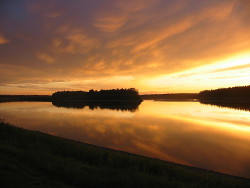Hydrological Modelling of Alberta – Peace/Slave River Basin
The Peace River begins in the mountains of British Columbia, and flows to Alberta. It is part of the Mackenzie River system, which eventually drains into the Arctic Ocean. The W.A.C. Bennett Dam is located on the Peace River in British Columbia and influences the stream flow downstream. The Peace/Slave River Basin includes the Wapiti, Smoky, Little Smoky and Wabasca rivers.
The river flows northeast across Alberta, through the town of Peace River and empties into the Slave River. At Peace Point, the Peace River has a mean annual discharge of 68,200 million cubic meters, and a drainage area of 293,000 km2.
The Peace/Slave River Basin covers an area of about 180,000 km2, is the largest river basin in Alberta, occupying approximately 30 % of the province. The mean annual natural river discharge of the Peace/Slave River is 108,000,000 dam3.
In 2001, the basin had a population of 133,973 people, which represents 5% of the provincial population. The basin had a population density of less than one person per square kilometre. The Peace/Slave Basin covers all or parts of 17 rural or regional municipalities and includes 15 Aboriginal settlements and 22 urban municipalities.
Allocations to the other sector account for 39 % of allocations (92,436 dam3) and the industrial sector accounts for another 37 % (691,866 dam3). The municipal sector accounts for 11 % (27,141 dam3) and the petroleum sector accounts for another 8 % (20,547 dam3). Total allocations in the Peace/Slave Basin in 2005 were 243,398 dam3.

